“Love in Vain” (Robert Johnson)
Another Robert Johnson song. Willie Mae was one of Johnson’s many “women friends”. Years later Willie Mae cried when she heard Robert call out her name on the recording. He must of really loved her!
Jazz Guitarist & Instructor
Another Robert Johnson song. Willie Mae was one of Johnson’s many “women friends”. Years later Willie Mae cried when she heard Robert call out her name on the recording. He must of really loved her!
Some times it is hard to believe but I have been chasing Robert Johnson’s music and ghost for fifty years and I have Eric Clapton to thank or blame for the chase depending on your point of view. In December, 1966 the record album, “Fresh Cream” was released by the British rock group “Cream” featuring Eric Clapton, Ginger Baker and Jack Bruce. The record included a track entitled “Four until Late” featuring Eric on vocals. I was fourteen years old and for some mysterious reason drawn to the tune. The listing on the back of the cardboard album cover credited the song to someone named Robert Johnson. I kept wondering who this fellow was and the name stuck in my head.
Almost a year later I was pawing through some records at a local store and stumbled across a Columbia record entitled, “Robert Johnson, King of the Delta Blues Singers” which depicted a painting of a man sitting on a chair playing a guitar. I studied the song listing on the back but “Four Until Late” was not listed…still this had to be the same Robert Johnson. I purchased the record but was not prepared for what followed. The songs had been originally recorded in 1936 and 1937 but through the scratchy grooves came a voice and a guitar so haunting, so very deep that it shook me. I studied the notes on the back of the record over and over focusing on the sheer poetry of some of the lyrics. “Robert Johnson, King of the Delta Blues” had been issued by Columbia in 1961 and at the time very little was known about the musician. The mystery surrounding Johnson amplified by his astonishing music grew to almost unbelievable proportions. There were no photographs of Johnson and his alleged encounter with Satan at the “cross roads” heightened the intrigue. For a time it seemed Robert Johnson was destined to take his place among other American folklore giants like “Pecos Bill” and “Paul Bunyan” except Robert Johnson had indeed lived and we had his recordings to prove it. These recordings sent the musicologist and historians scampering throughout the Delta to piece together Johnson’s life.
In 1989, Peter Guralnick’s book, “Searching for Robert Johnson” was published and it featured the only know photograph of Johnson on the cover which had been discovered in the same year by Steve LaVere. My hands trembled as I held the book at the Barnes & Noble bookstore in downtown Philadelphia. I studied the photo of Johnson holding a Gibson L-1 guitar, his long slender fingers, the jaunty tilt of his Stetson hat, and the crisp ironed creases in his suit. I was amazed.
In 1990, the mother load from the Columbia Record vaults was issued entitled, “Robert Johnson, The Complete Recordings”. Finally we had all of the known Johnson sides. The forty seven page booklet inside included a second discovered photograph of Johnson, a reproduction of his death certificate, the lyrics to his songs and essays covering his life and influence. We learned that Johnson died on August 16th, 1938 in Greenwood, Mississippi under mysterious circumstances. He was only twenty seven years old. Since that time, numerous books, a documentary, music transcriptions and tribute records have been published exploring Johnson’s life and music. The interest in Johnson’s life and music remains high and the flood continues to this day.
However, the circumstances involving Robert Johnson’s death and the exact location of his burial site remain shrouded in mystery. In 2014, I made a journey alone to the Mississippi Delta to visit the three possible Robert Johnson grave sites and some of the places mentioned in his songs.
In the song, “Traveling Riverside Blues”, Johnson mentions Friars Point, Rosedale and Vicksburg. I visited all three places but found Friars Point especially haunting. It is a small poor hamlet which was a center of commerce from nearby plantations. There is a small row of storefronts where Muddy Water’s stated he saw Johnson playing on the street. Here are those store fronts at Friar’s Point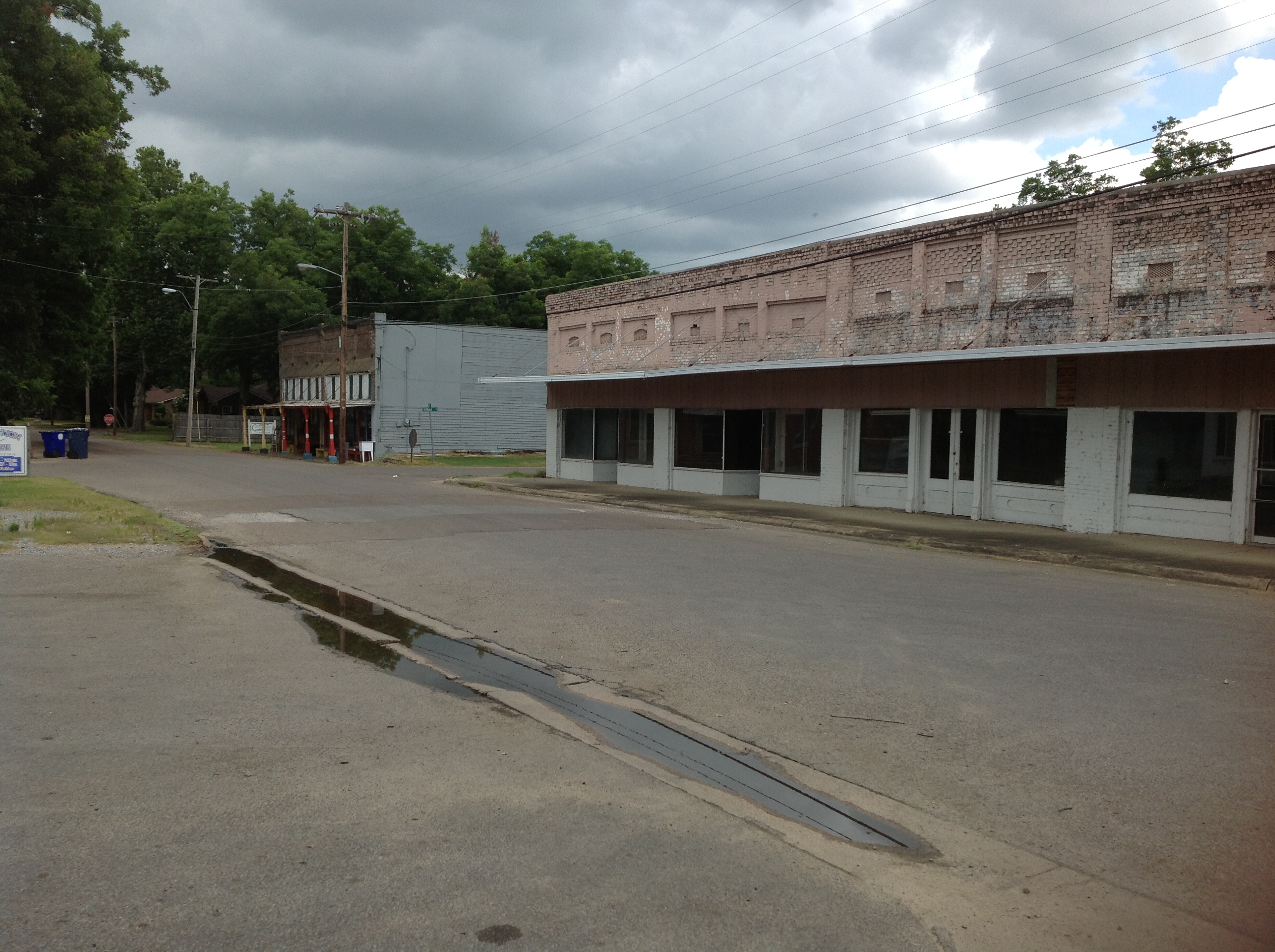 where Johnson performed.
where Johnson performed.
I had arrived at Friars Point around dusk, it was a Sunday and there wasn’t a soul around. As I stood there I could almost see Johnson standing there with his guitar, performing for loose change in front of the storefronts.
Finding Robert Johnson’s grave site was another matter entirely since the exact location of his grave is officially unknown and there are three possible church grave yards with markers erected around the outskirts of Greenwood, Mississippi where he might be buried. I decided to visit all three and let the vibes I might feel determine Robert’s final resting place. The first site I visited was the Payne Chapel near Quito, Mississippi.
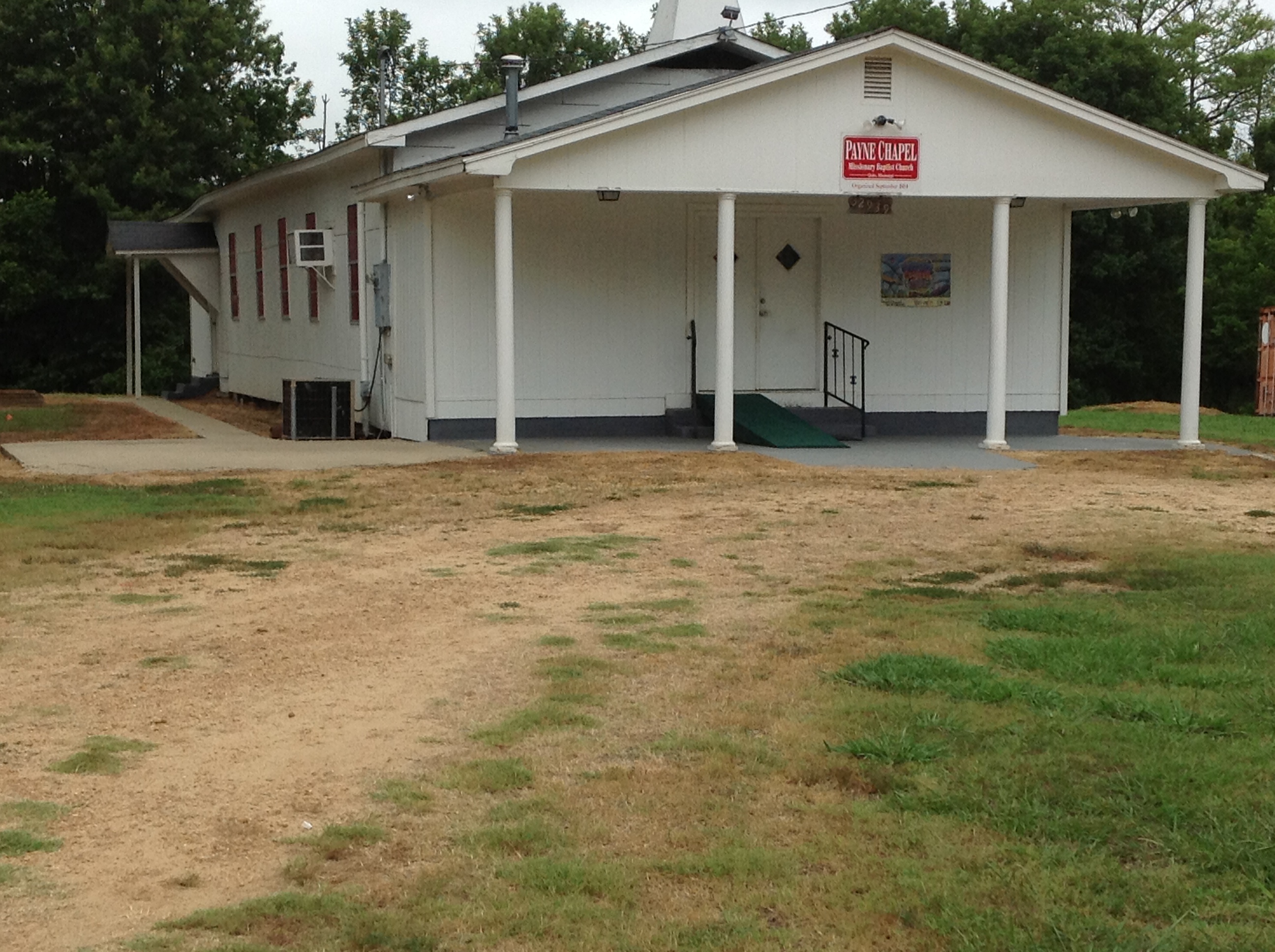
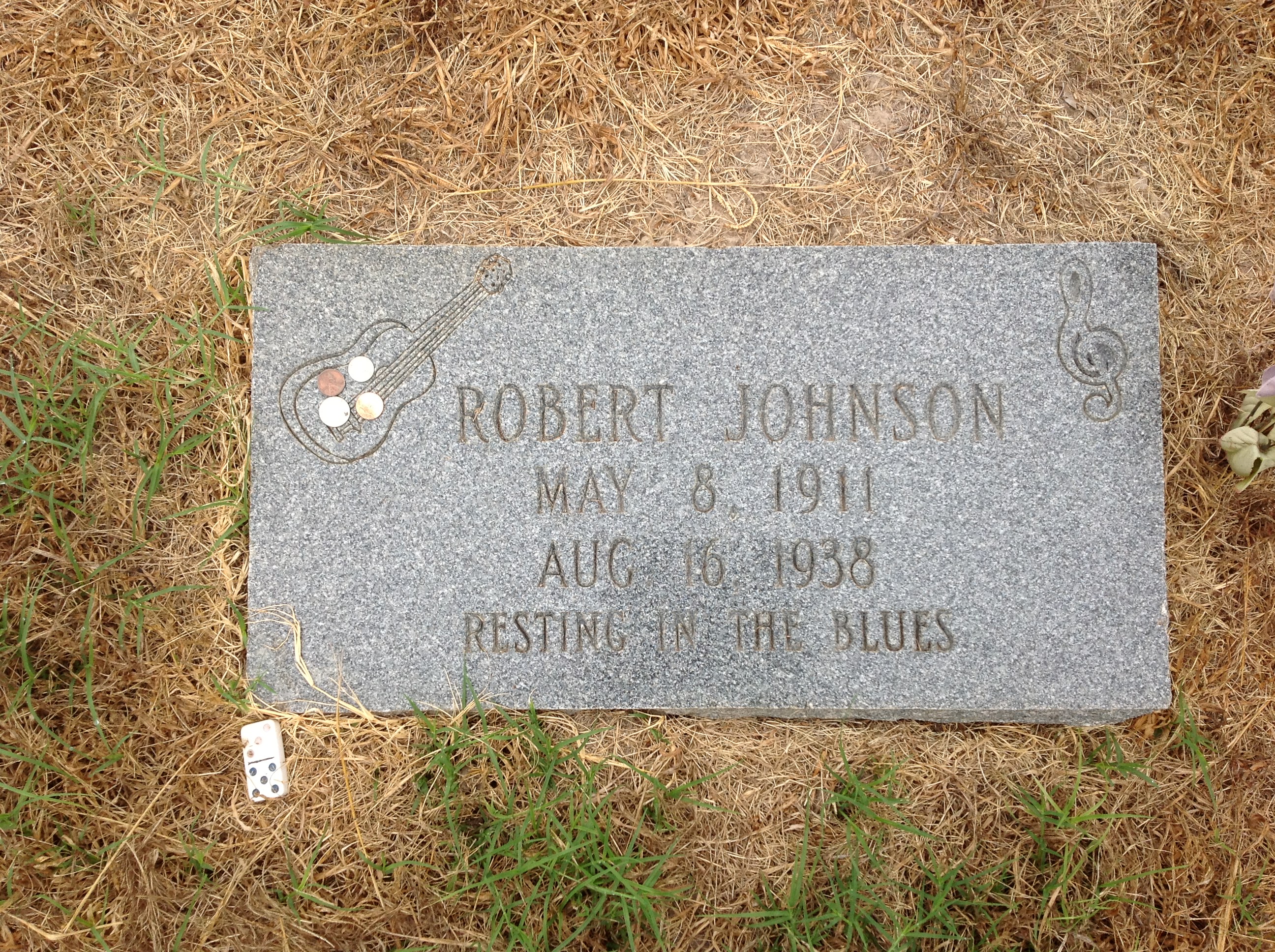 It was early Monday morning and nobody was around. I wandered around the cemetery studying each headstone. I was getting a little flustered and wondered if I was at the right place. It had taken me some time to find the church. I calmed myself, reflected and turned around and there it was.
It was early Monday morning and nobody was around. I wandered around the cemetery studying each headstone. I was getting a little flustered and wondered if I was at the right place. It had taken me some time to find the church. I calmed myself, reflected and turned around and there it was.
The stone read, “Resting in the Blues”. I stood there for a while, said a prayer but did not feel anything special. I was not to sure that he was buried here.
After a few minutes, I got in my car and drove about six miles to Morgan City, which wasn’t a city at all but just a little crossroad hamlet. I saw a church but it did not turn out to be Mount Zion Missionary Baptist Church where Johnson might be buried. I pulled my car over to a small dilapidated gas station where a few workers were gassing thier cars. The two men looked at me suspiciously as I approached, “Excuse me gentlemen, I’m looking for the Mount Zion Missionary Baptist Church where Robert Johnson is buried.” They gave me a whimsical look, realizing I was another Blues tourist and kindly gave me directions “Go back down the road. Make a right at the third intersection and follow the road along the river until you come to a bend in the road….the church is on your left.” I thanked them and motored back down the road. Their directions were great but I drove right by the church and had to turn around after a couple of miles til I saw a small white wooden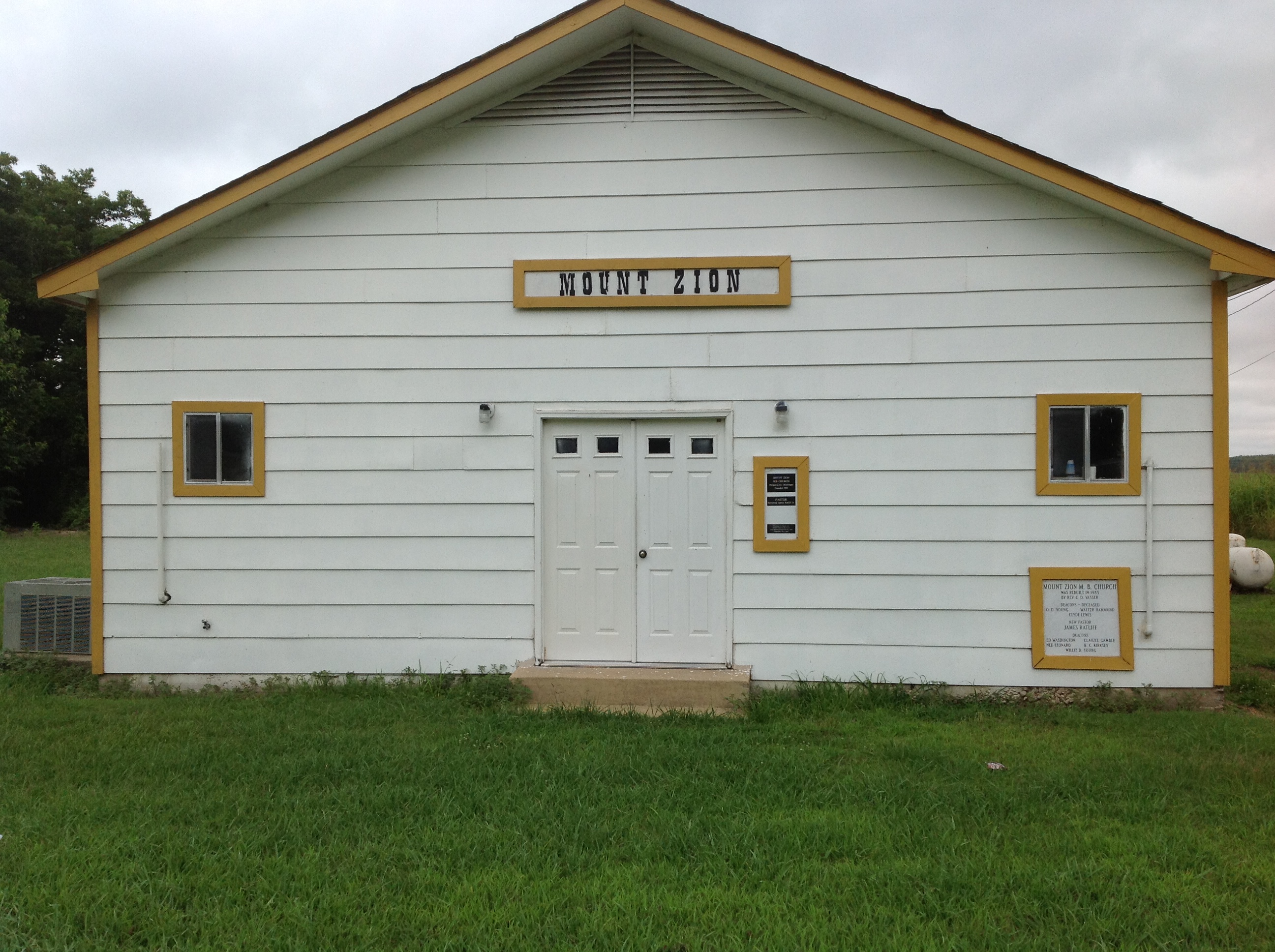 building.
building.
Supposedly Robert Johnson was buried in an unmarked grave in the church lot. There were not a lot of other grave markers so it was not hard to see the large granite marker placed in the yard by John Fogerty, Peter Guralnick and Columbia Records in 1990.
I studied the monument for a while reading the inscriptions carefully. It sure was a peaceful spot but I did not feel anything extraordinary. Although it was certainly possible, I did not think Robert was resting here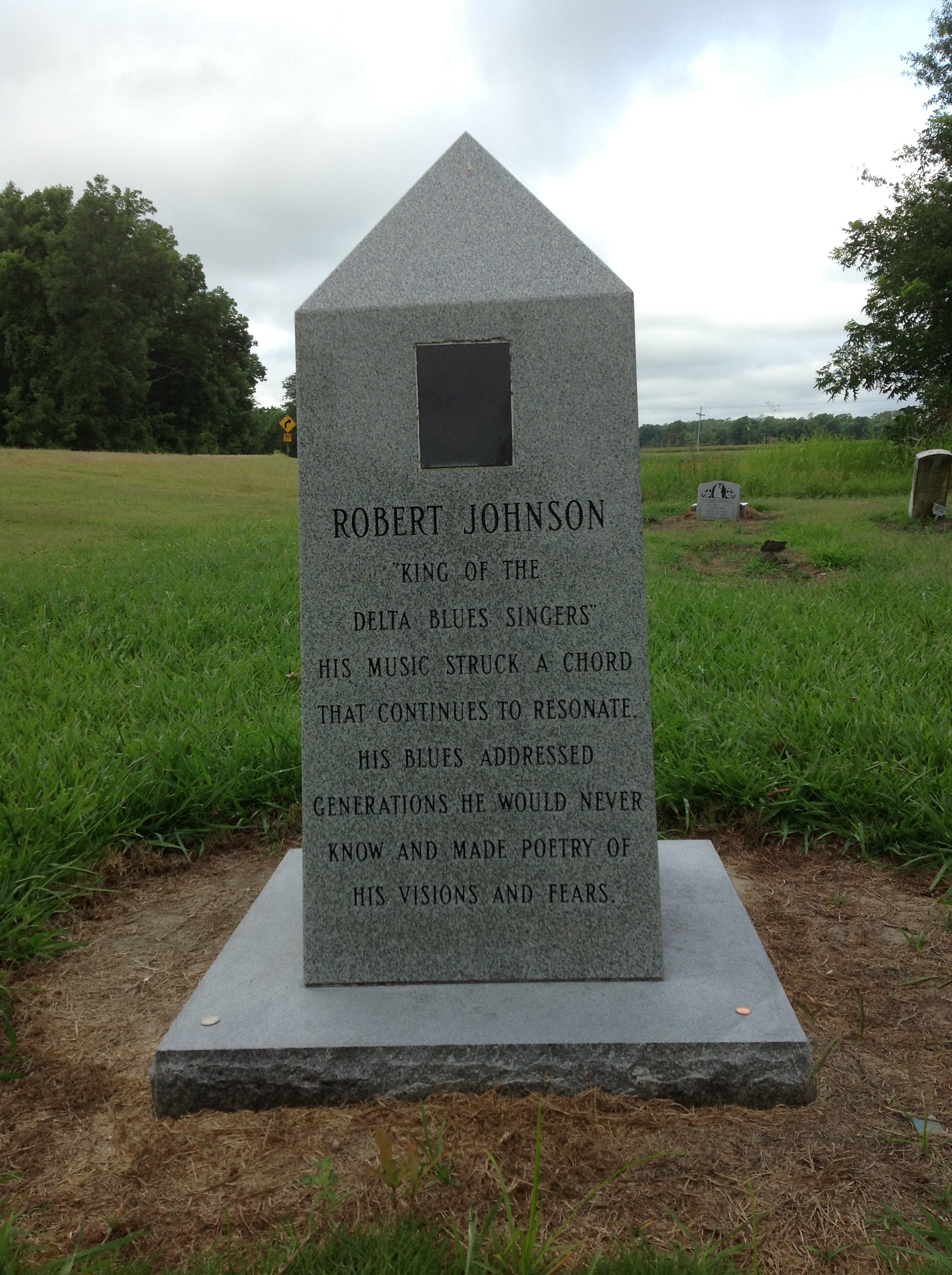
I sat for a few minutes resting in the Delta heat and said another silent prayer before pushing on to the third possible grave site located at the Little Zion Church just north of Greenwood.
Greenwood, Mississippi turned out to be an interesting and thriving little town for the Delta. I parked my car downtown right in front of the Greenwood Chamber of Commerce and walked right in. Behind the counter stood a handsome elderly woman with a regal bearing. Her shiny gray hair was tied back neatly in a bun. ” Hello sir, welcome to Greenwood….how can I help you?”, what a charming woman I thought. Her diction was clear but dripped with a honey Southern accent. “Well, I’m looking for the Robert Johnson grave site…I already visited two of them but I am looking for the Little Zion Church grave site. I need directions…”, I asked, suddenly realizing I was a little embarrassed since I had been on the road and looked like a mess. “Ahh….Robert Johnson…..of course I can help you. Did you know the grave site at Little Zion is the only one officially authenticated by the State of Mississippi? We are certain poor Robert is buried there.”, she answered. Then she proceeded to tell me in a detailed manner the entire story of the identification of the site by the graveyard digger’s daughter, Rose Eskridge who witnessed the burial. Apparently the Little Zion Church, was very near to the tenant shacks on the plantation were Robert Johnson died. the kind women gave me exact directions and wrote them down in neat handwriting for me. I thanked her profusely and started towards the door. “Watch out for snakes in the high grass when your out there!”, she warned as I walked out. “Snakes…………I guess they tie into the myth of Johnson selling is soul to the devil.“, I mused.
Her directions led me north out of Greenwood across the Yazoo River until green plantation farm fields lined each side of the two lane road. After about six miles, I saw the church on the left side of the road. 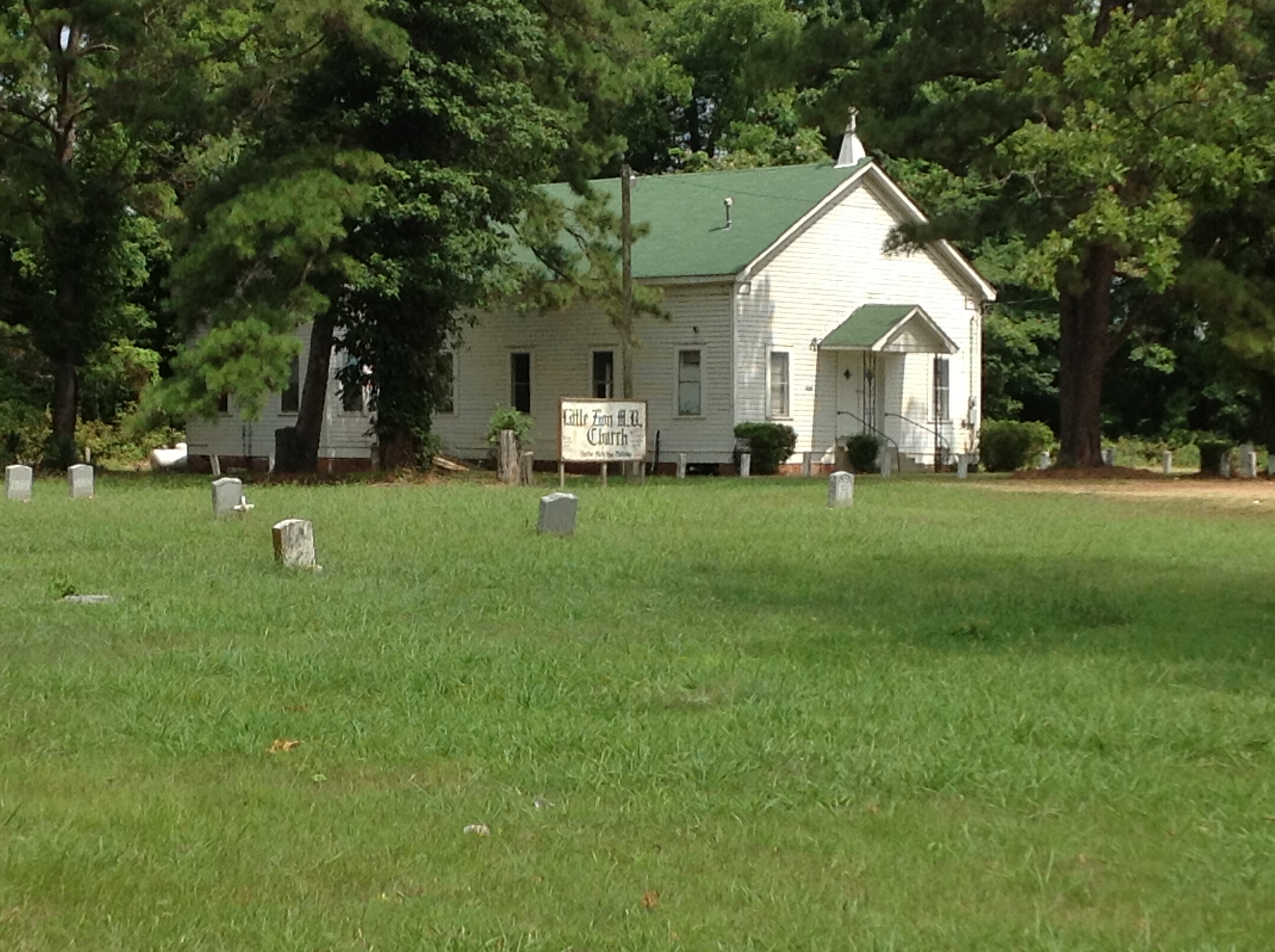
There was a historical sign post marking the location and I noticed the words, ” He is thought to be buried in this graveyard.”
 The nice lady from the Greenwood Chamber of Commerce, specifically said that the grave was located towards the back of the cemetery and situated under a large tree. I started walking through the grass, reading the the gravestones with one eye and watching out for snakes with the other. Then I spotted a large tree towards the back of the cemetery.
The nice lady from the Greenwood Chamber of Commerce, specifically said that the grave was located towards the back of the cemetery and situated under a large tree. I started walking through the grass, reading the the gravestones with one eye and watching out for snakes with the other. Then I spotted a large tree towards the back of the cemetery.
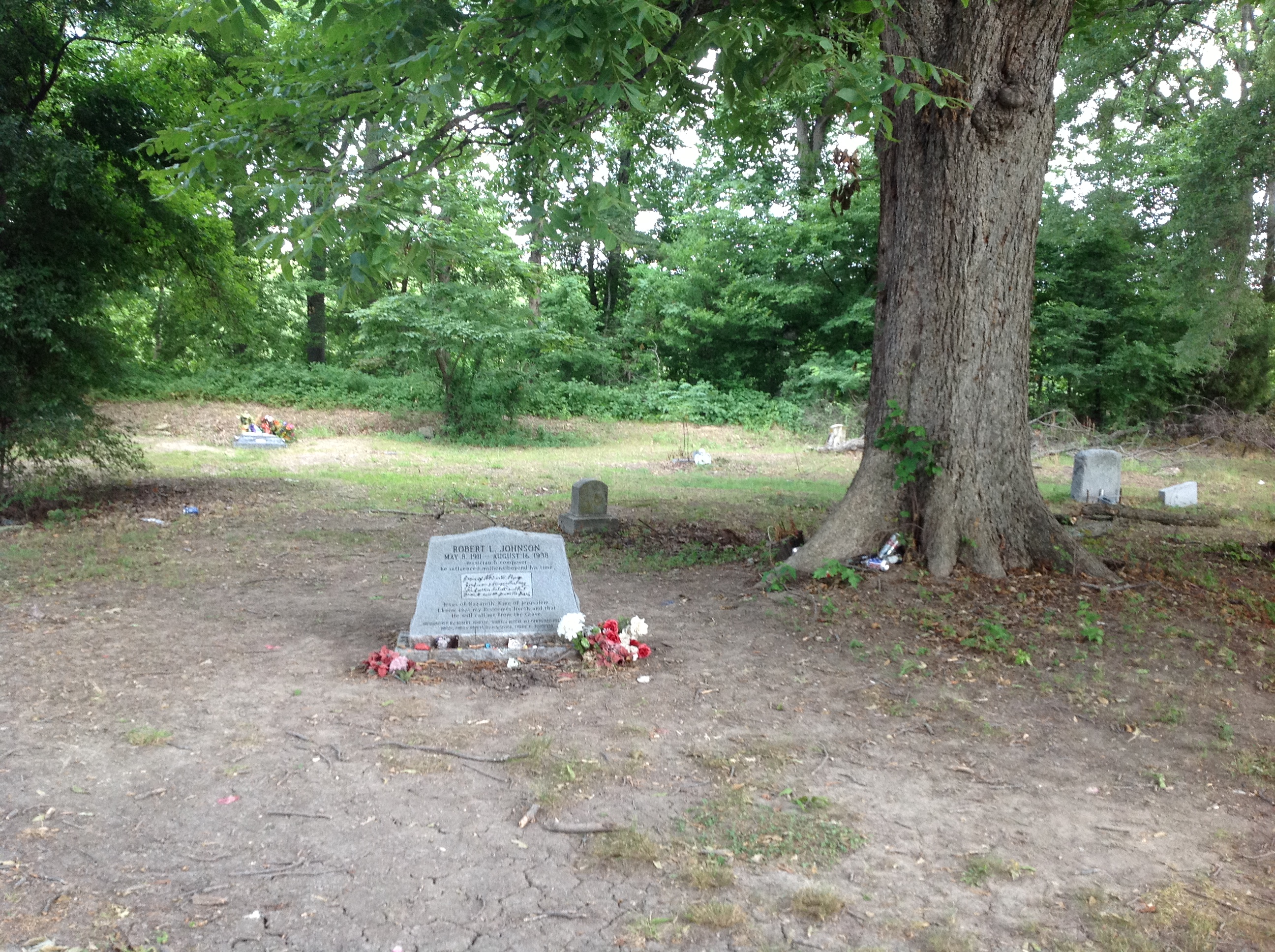 Underneath the tree lay a head stone with some flowers scattered along the base. As I walked towards the grave, there was a light warm breeze coming across the Delta farm fields. The leaves in the tree above the grave gently rustled. Somehow, I knew Robert Johnson, the great blues poet was buried here. I had no doubt. I had a feeling of certainty and said a silent prayer.
Underneath the tree lay a head stone with some flowers scattered along the base. As I walked towards the grave, there was a light warm breeze coming across the Delta farm fields. The leaves in the tree above the grave gently rustled. Somehow, I knew Robert Johnson, the great blues poet was buried here. I had no doubt. I had a feeling of certainty and said a silent prayer.
Along the base and top of the grave marker, other blues pilgrims had places coins, guitar picks, bottleneck slides and flowers. I stood there and soaked it all in. Here was a twenty-seven year old, uneducated wandering Blues musician who’s scant recordings from the thirties became the bedrock of modern Blues and Rock & Roll. During his lifetime, he was hardly a blip in time. Now famous musicians, rock stairs and Blues devotees from around the world travel to this site to pay their respects. Mutual respect from fellow musicians is the thing most highly treasured by all musicians. After over 75 years Robert Johnson is still receiving the deserved respect from musicians all around the world.
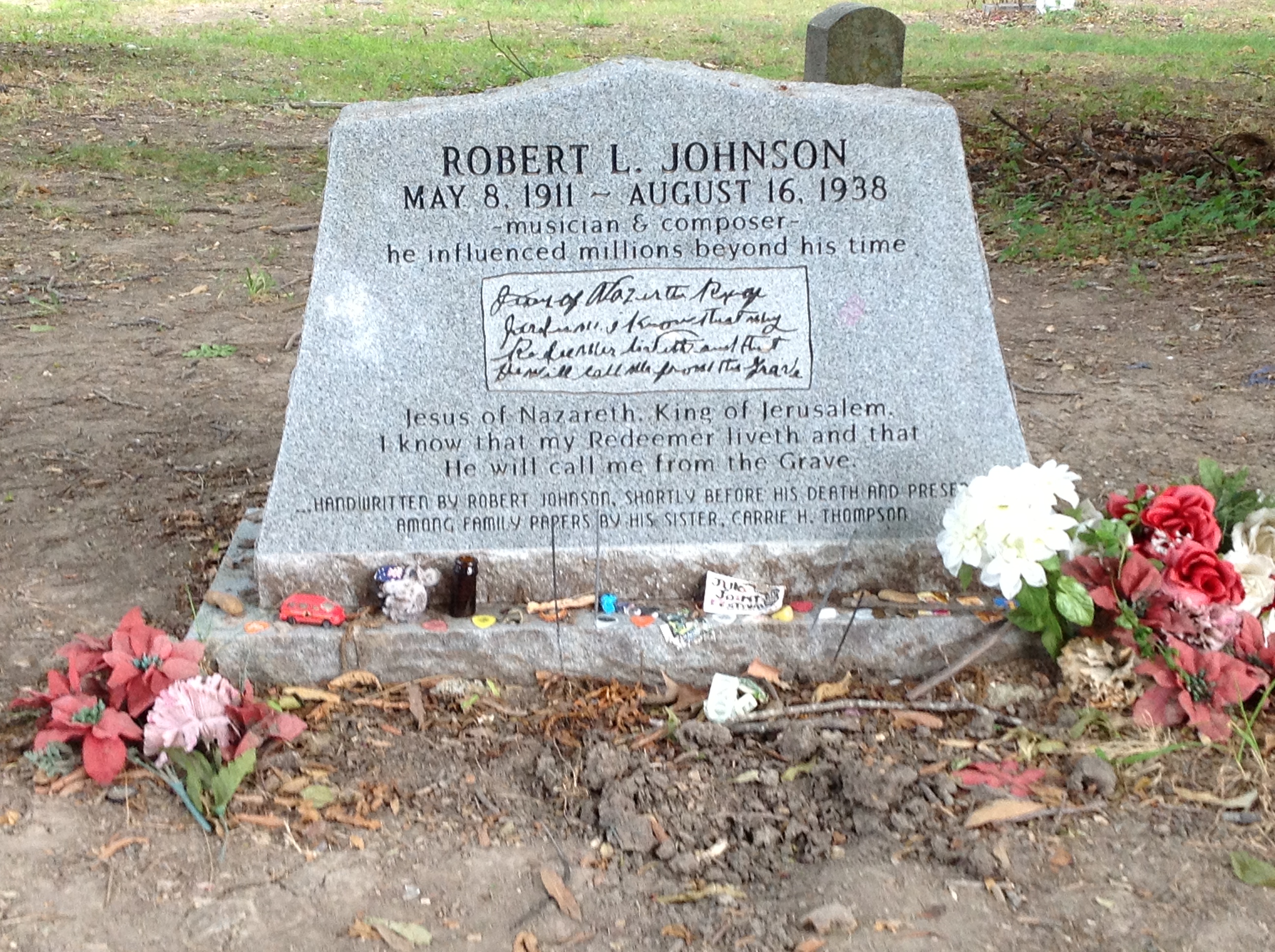 I was alone in the cemetery that morning and I sat for some time reflecting on Robert Johnson’s music and my sojourn to this place after so many, many years. What did it all mean? Since 1966, I have drawn oceans of inspiration from listening to and playing Robert Johnson’s music and I have return to the his musical well over and over, always learning or feeling something new. Yes… I thought, that is what it all means. Thank you Robert Johnson.
I was alone in the cemetery that morning and I sat for some time reflecting on Robert Johnson’s music and my sojourn to this place after so many, many years. What did it all mean? Since 1966, I have drawn oceans of inspiration from listening to and playing Robert Johnson’s music and I have return to the his musical well over and over, always learning or feeling something new. Yes… I thought, that is what it all means. Thank you Robert Johnson.
If you wish to learn more about Robert Johnson and his music I highly recommend you check out:
Please check out my humble rendition of Robert Johnson’s classic, “Come into My Kitchen” in the video section of this website.
Stephen C. Foster (July 4th, 1826-January 13, 1864), in my humble opinion, was America’s greatest songwriter. His contributions to America’s deep musical legacy include “Oh! Susanna”, “Beautiful Dreamer”, “Old Folks at Home” and “Jeanie with the Light Brown Hair”. One of my fondest childhood memories is music time at St. Francis grammar school when we would open an old faded text book entitled “America’s Greatest Songs”. Inside the worn pages were many of Foster’s greatest compositions and the good Sisters would lead us in singing them one by one. Experiencing Foster’s songs at such an early age left a deep imprint on my musical psyche. Today as I teach children guitar, I am saddened, more often than not, to learn these children have no idea who Stephen Foster is nor have any familiarity with his music. This being the case, I have considered it my responsibility to introduce them to Foster’s music and tell them a little bit about his life.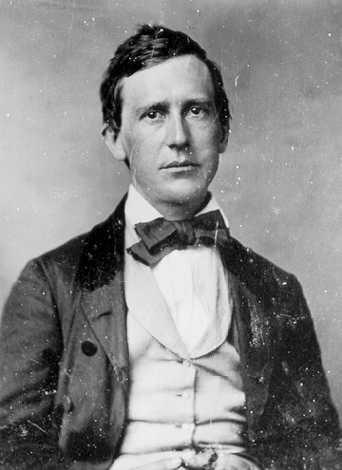 Although many of his compositions are written about the South, Foster was born on July 4, 1826 in Lawrenceville, Pennsylvania and spent most of his life in the Northeastern part of the U.S. Foster taught himself to play many instruments including the clarinet, violin, flute and the piano. He also learned to read and write music,with some instruction from Pittsburgh musician, Henry Kleber. In his lifetime, Foster wrote over two hundred songs and some captured the imagination of the American public like never before. For example, his song “Oh Susanna!” became the theme song of the California Gold Rush. Later in life, Foster became estranged from his wife and children, and while in New York City became ill with a fever. He died alone and in poverty on January 13, 1864. He was thirty seven years old. It was a sad ending, but his music is highly celebrated today and lives on.
Although many of his compositions are written about the South, Foster was born on July 4, 1826 in Lawrenceville, Pennsylvania and spent most of his life in the Northeastern part of the U.S. Foster taught himself to play many instruments including the clarinet, violin, flute and the piano. He also learned to read and write music,with some instruction from Pittsburgh musician, Henry Kleber. In his lifetime, Foster wrote over two hundred songs and some captured the imagination of the American public like never before. For example, his song “Oh Susanna!” became the theme song of the California Gold Rush. Later in life, Foster became estranged from his wife and children, and while in New York City became ill with a fever. He died alone and in poverty on January 13, 1864. He was thirty seven years old. It was a sad ending, but his music is highly celebrated today and lives on.
My favorite Foster song is “Hard Times, Come Again No More”. It was first published in 1854 and is still being performed by contemporary artists today. It is a story song about the suffering poor. Its pleading melody and powerful imagery makes it a great work of the songwriting art. I have video taped my version of “Hard Times, Come Again No More” for your viewing in this website.
It is fitting but somewhat ironic that Stephen Foster, “America’s Greatest Songwriter” was born on the Fourth of July in 1826 and died in the final full year of America’s greatest tragedy and triumph, the Civil War. He was truly America’s Son.
It was May of 1976 and Spring was in the air in my hometown of Geneva, N.Y. I flung open the door and bounded up the stairs to my Cousin Al’s apartment on the third floor of an old building above the Noah’s Ark store on the corner of Castle and Exchange streets. My cousin Al, a year older, had started playing guitar the same time as myself right after the Beatles triumphant U.S. arrival in 1964. Although we had taken divergent musical paths, Al was now an accomplished musician and somewhat of a minor celebrity in the Finger Lakes area due to his original rock band, “The Checkers”.
Cousin Al’s apartment was a complex of adjoining rooms that once must have been office space. Al’s apartment led to a large adjoining space, used for rehearsals and jams and that led to another complex of rooms occupied by our mutual friend, Mike, who was a modern painter and photographer. The collection of rooms was known as “The Loft” or alternatively “The Complex.” It had become a gathering point for like minded artists and bohemians living in the area. The door was always open and there was always something artistically exciting happening. I visited as often as I could to participate in experimental music jams, political and philosophical discussions and other “forms of entertainment” the “Complex” might offer at any given moment.
As I walked into the front room, Cousin Al, our mutual friend Jeff and assorted girl friends were sitting around attentively listening to an LP entitled the Sargasso Sea on the ECM record label. It was a duo guitar recording by jazz guitarist, John Abercrombie and guitarist Ralph Towner. The music playing immediately struck me as something that was very different and astonishing. I was mesmerized by what I heard.
The actual Sargasso Sea sits in the middle of the North Atlantic Ocean and is the only sea on Earth with no coastline. It is distinguished by is brown Sargassum seaweed and calm deep clear blue water. Throughout literary history, the Sargasso Sea often depicted as having mysterious qualities.
Abercrombie and Towner’s music on the Sargasso Sea record echo’s the sea’s characteristics. It is clear, atmospheric, mysterious and often painfully beautiful. Abercrombie and Towner weave acoustic and electric guitar improvisations within loose and floating harmonic and rhythmic parameters allowing the music to breath. These characteristics set this record apart from other guitar duos (e.g. Herb Ellis/Joe Pass) of the time. Caution! The impressionistic nature of the Sargasso Sea requires diligent listening to reap all the rewards it has to offer.
The Sargasso Sea was not an over whelming success when it was released in 1976 but like all great music it has stood the test of time. It has been forty years since being released but every time I listen to the Sargasso Sea, it still sounds fresh and timeless. There is always something new to hear.
The songs on the record are all original compositions by Abercrombie and Towner. Here is the track listing:
I still have the original ECM vinyl released but was overjoyed when ECM released it on Compact Disk several years ago and it is readily available. The Sargasso Sea wasn’t the only musical discovery I made while visiting the “Complex” but it was a lasting one. Thanks Cousin Al!
I first heard the folk song, “Hang Me, Oh Hang Me” on an early Dave Van Ronk record entitled, “Inside Dave Van Ronk”. Later when I was working with Bill Felix’s bluegrass band, “Magnolia Road”, Bill would pull out his old beat up Gibson flat top guitar and sing the tune….he learned it from a Gerry Garcia version but gave it his own twist.
I always loved the song but had forgotten about it. I stumbled upon it again when it was featured in the Coen Brothers film, “Inside Llewyn Davis” and performed by the actor/musician Oscar Isaac. Isaac’s version was a nice rendering largely based on Van Ronk’s recording of the tune.
Nobody is exactly sure how the song originated and like most folk songs there are different versions on the song with a few different titles. The song has been performed as “I’ve Been All Around This World,” “The Gambler,” “My Father Was a Gambler,” “Cape Girardeau,” and “The New Railroad.” The Library of Congress documents the first version to be recorded as“I’ve Been All Around This World” (AFS 1531) by Justis Begley. Alan and Elizabeth Lomax, the great folk song musicologists, recorded Alan Begley singing the song at Hazard, Kentucky in October of 1937.
So who is the condemned man singing the song? Nobody knows for sure but there is high speculation that it may be one of the men hanged in Ft. Smith, Arkansas by the notorious “hanging judge”, Judge Isaac Parker between 1873 and 1876. Some people believe the man in song is John Childers who spoke for sixteen minutes on the scaffold. The U.S. Marshall who had arrested Childers offered clemency to the condemned man if he would reveal the names of his accomplices.
According to witnesses that day, Childers would not “rat out” his friends. He turned to the Marshall and stated, “Didn’t you say you were going to hang me?” The Marshall nodded his head yes and then Childers replied, “Then, why in hell don’t you!”
Here is my version of “Hang Me, Oh Hang Me”. I play it in D major as Dave Von Ronk but Iam tuned to a Drop D tuning. I slowed my version down and added an instrumental solo. I hope you like it.
Roni Ben-Hur is a known name in the jazz guitar world. He has for many years been an active player and teacher on the New York scenne. In addition, Roni has recorded several excellent records. (Check out Roni’s “Signature” on Reservoir Records.)
In 1985, Roni initiated studies with the famous bebop pianist and educator, Barry Harris and this has highly influnced his approach to the guitar. Talk Jazz adapts much of Barry’s improvisational approach to the guitar in a series of single note exercises. I purchased the book in 2008 from Roni’s web site and it is 268 pages of serious excercises. Talk Jazz has been part of my daily studies since then and I have worked through the entire book several times and continue to do so.
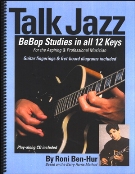
What is great about this book is that is an alternative to building “chops” with out running through a lot of unmusical scales. I particularly like the minor and major sixth diminished exercises. The surround note exercises and the arpeggio studies are also favorites.
Mel Bay published a truncated version of the book which is widely available on the market but I would try to get your hands on the original version with all 12 keys notated. Highly recommended!
I first became aware of Pat Martino in 1975 when I read an article about him in the Guitar Player Magazine compilation book entitled “Jazz Guitarists”. I was just starting my studies in jazz guitar and would read everything and anything that was available on the subject. The article was entitled “I See the Guitar in Everything”. The article was a little confusing to me. Pat was explaining his symmetric divisions of the one octave:12 point star………..heady stuff for a neophyte!
A year later I stumbled across “Exit” in the record bins in a record store in Ithaca, New York near Cornell University. “Exit” was originally released on the Muse record label and was recorded on February 10th, 1976. It featured Richard Davis on bass, Bill Hart on drums and Gil Goldstein on piano. The songs included “Exit”, “Come Sunday”, “Three Bass Hit”, “Days of Wine and Roses”, “Blue Bossa” and “I Remember Clifford”. The front cover had a picture of Pat walking with his back to a camera on a dock towards the ocean. On the back was a picture of Pat where he seemed to have a sad or slightly tormented look on his face.
In 1980, Pat Martino was rushed into surgery to treat a near fatal brain aneurysm. When he awoke from the surgery, he had lost all memory of who and what he was and disappeared from the music scene until 1989. It took him nine years to continue his career again as a jazz guitarist. When I listened to “Exit” for the first time, I was struck by the deep fat and metallic sound Pat was able to achieve on his guitar. I was both spell bound and amazed by the long flowing and extremely meticulous creative lines he played . Behind all the music I felt a deep sense of melancholy coming through, especially in the ballads. Here was Pat Martino at the peak of his powers a few years before the surgery.
Although I have all of Pat’s recordings which are all excellent and to be studied closely by all musicians, I find myself constantly returning to “Exit” for spiritual and musical nourishment. There is something special and magical about this recording to me. I have always found Pat’s music to be very spiritual and healing in nature and “Exit” somehow captures something mystical which I can’t explain. Pat Martino is a national treasure. His story is a remarkable and inspirational one of an enduring artist arising out of the ashes of nothingness to fly again. He is an artist of the highest quality.
Flat Pickin’ Floating Exercise – Part I – Key of C
Hello fellow guitarists! Here is a flat picked floating exercise in the key of C to help you get around efficiently up and down the fret board.
The term “floating” is often used by flat pickers. Floating is simply a technique of using open strings to move between positions on the fret board without losing the continuity of musical thought. Floating is not unique only to Bluegrass flat pickers but is used to great effect by finger style players as well as classical players. In fact, I was just reading through a Fernando Sor exercise in B minor which used an open B string to move from the open position to the six position on the fret board. In addition, the great finger style jazz guitarist, Lenny Breau often used floating in his improvisations to great effect!
Since open string notes are necessary, C major and sharp keys work best . However, as long as open strings can be utilized, floating will work in flat keys as well. Using the open strings in conjunction with fretted notes played in rapid succession produces a cascading chiming effect which is very pleasing to the ear. Since floating is used extensively by flat pickers, this exercise will be centered around Bluegrass flat picking style. The music notation and tab is included in the links below on PDF files.
Exercises A.1. & A.2.
Flatpicking-Exercise-Page-1-31.pdf
Exercise A.1. is a one octave C major scale utilizing the open D, G, B and E strings. It will move you from the open position to the fifth position on the fret board. When you first try this, using the open strings will feel counter intuitive to the normal fretted scale positions, so practice it very slowly using a metronome until it begins to feel more natural. Listen to the chiming effects produced as you increase the tempo.
Exercise A.2. is the C major scale covering two octaves. Be careful of your fingering and use alternate up and down picking. Once again, make sure to practice this exercise very slowly and correctly and then increase the tempo gradually. It will take some work but you will get it!
Exercises A.3. & A.4.
Exercise A.3. Introduces the C minor pentatonic scale. Since there are three flats, the only open string we can utilize is the G but this allows us to move effectively from the third position to fifth position and higher. The C minor pentatonic scale will be utilized over a C major chord in produce a bluesy sound which is very common in Bluegrass soloing. The Eb provides a minor 3rd against the major chord creating a crying sound. Try mixing this scale with the C major scale.
Exercise A.4. Adds the flat fifth (Gb) to the C minor pentatonic producing the C Blues scale. The flat fifth is another common sound in Bluegrass, Blues and Jazz soloing.
Exercise A.5.
Here are four licks utilizing floating to create lines using both the Major and Blues scale in C. Notice how we can move up and down the fret board. Practice these and then create your own licks!
Fiddle Tune – Wagoner
Here is a version of the traditional fiddle tune “Wagoner” in the Key of C using the floating concept with the E, B, G and D open strings. Work on this tune to help build your coordination with the fretted and open strings as well as moving up and down the fret board.
Conclusion
I hope you have enjoyed these exercises. Look for more floating exercise in the Keys of G, D, A & E in the coming months!
I first noticed Richard S. Saslow’s book entitled “The Art if Ragtime Guitar” in 1975 in an advertisement in the back section of the November issue of Guitar Player Magazine.
The advertisement read:
“ Green Note’s latest. Complex finger picking moves you beyond traditional two and three chord songs and into the sounds and chord progressions of early jazz. The demonstration record, together with transcriptions, musical analysis, and nearly 100 instructional photos, make clear numerous finger picking techniques, some never before discussed in print. The finest book on finger picking guitar yet produced. Tab included”
Yahoo….and all for the whopping price of $4.95! I was sold. After all, I had been listening carefully to Blind Blake, Blind Boy Fuller and other rag guitar icons after being introduced to them by Boston ragtime guitarist Pete Kairo and Yazoo Records. I eagerly ordered my copy. The book came a few weeks later complete with the little flimsy plastic record and I began to dig in.
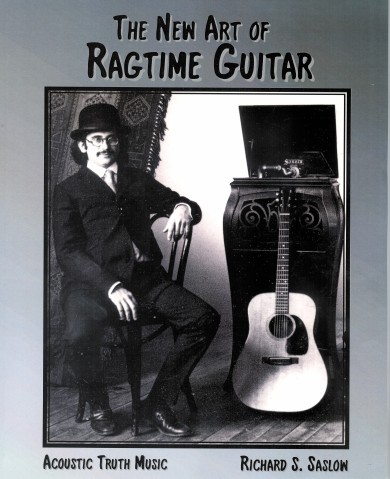
The book was just as advertised. Richard had composed seven original ragtime pieces and he included extremely detailed instructions for each piece as well as the scores in musical notation and guitar tablature. The book contained three sections. The first section is a general review of finger style technique for the ragtime style. Richard covered both the right and left hand essentials in great detail using pictures, chord grids, musical notation and tablature to great effect.
The second section included a very detailed analysis of segments of measures for each composition. This section is so complete that any student determined to play the ragtime style can learn how to do so with some concentrated practice.
The last section includes the complete scores of each composition and Richard’s songs are extremely musical, well constructed and fun to learn. The tunes are written in C and few other sharp keys friendly to the guitar. The chords used in the compositions include a combination of open, barred and broken string chords and the songs are graded from the least challenging to the most challenging as the book progresses. Any student who digests Richard’s book will have a great foundation for ragging the blues in an ad hoc improvisational manner.
Unfortunately some where along the line of the many moves from upstate NY to Atlanta I lost the book. It may still be buried in some unopened box from one of the family moves. Who knows?
Any way, I was ecstatic when I learned the book had been republished by Richard Saslow in 2011 under the title “The New Art of Ragtime Guitar” for $24.95 and was readily available on the net. I quickly ordered my copy again but this time there was no little flimsy plastic record but MP-s files downloaded from the Internet. The songs and format are identical to the original book except Richard has added one additional composition entitled, the “Absquatulation Rag”
After playing through the compositions in the book, I felt like I had found a long lost friend. I have already begun to use “The New Art of Ragtime Guitar” with some of my students. I highly recommend this book to any player who wants a solid introduction to ragtime fingerstyle.
Well done Richard and thank you!
Introduction
This is the second in a series of articles highlighting my favorite recordings. This is not a “best of all” list but simply some commentary on recordings that had a deep and lasting influence on me. The articles will cover all genres of music. Enjoy!
“Home in Sulphur Springs” by Norman Blake
I remember the day well. It was Friday afternoon in October, 1975 and I had just returned home from a stressful day at work. As I got out of my car, I spotted the brown rectangular package sitting upright against the door on my Apartment stoop. My spirits rose immediately! Not only was it Friday, but my long awaited package of treasures from Rounder records had finally arrived.
It was difficult to find small independent label recordings in the small upstate New York town where I lived. In the days before the Internet, ordering through the mail was the only option. I discovered the Massachusetts based Rounder records through a musician friend of mine named, Kevin McElroy. Kevin was from the Boston area and was a traditional Irish and roots musician. Kevin introduced me to real folk, bluegrass and country music.
I ran upstairs and eagerly ripped open the box. Among the six or seven recordings ordered was Norman Blake’s “Home in Sulphur Springs”. Norman recorded it in 1971 in Nashville. I had chosen this record after Kevin had played me “Will the Circle Be Unbroken”, the landmark recording by the Nitty Gritty Band. Norman was indeed featured on that record primarily playing some very, very tasty Dobro.

I savored looking at the “Home in Sulphur Springs” album cover. On the front was a large black and white photograph of Norman with what appeared to be a very worn slotted Martin guitar. Norman had on these round wire rim glasses, long hair and a good deal of facial hair. Of course, this was not too unusual for 1975. But some how he looked different …….his picture reminded me more of the Confederate soldiers taken prisoner and photographed at Gettysburg in 1863 than a 70’s hippie. Norman wasn’t smiling at all and seemed quite serious. On the back cover was a picture of an old steam train pulling cars over a wooden trestle bridge as well as some very interesting liner notes about Norman and the music.

I put on the record and some dynamic flat picking started off the magical musical journey with “Bully of the Town”. It only got better after that! Not only were there traditional songs but new songs Norman had written that were terrific. The standouts to me were the original compositions, “Crossing No 9.” and “Ginseng Sullivan”. The musicianship on all the songs was superb. Norman sang in a somewhat whiny southern drawl . It was obvious he was not trying to be commercial in any respect. The songs he had written sounded like they had sprung from the 19th century and were more akin to Stephen Foster or the Carter Family than the typical 70‘s acoustic music. The original songs were biographical and Norman spun them like a good story. Here was a great musician and songwriter!
I could go on and on but I would rather let you discover the fine gems in this recording on your own. Luckily, Norman Blake’s “Home in Sulphur Springs” was re-released on CD format by Rounder and is readily available. With all the hype about “Americana” music these days one can get easily confused on what is the real deal. If it was up to me, the definition of Americana music found in Webster’s dictionary would simply say, Norman Blake. If you are not familiar with Norman Blake and his many recordings, you owe it to yourself to check him out.